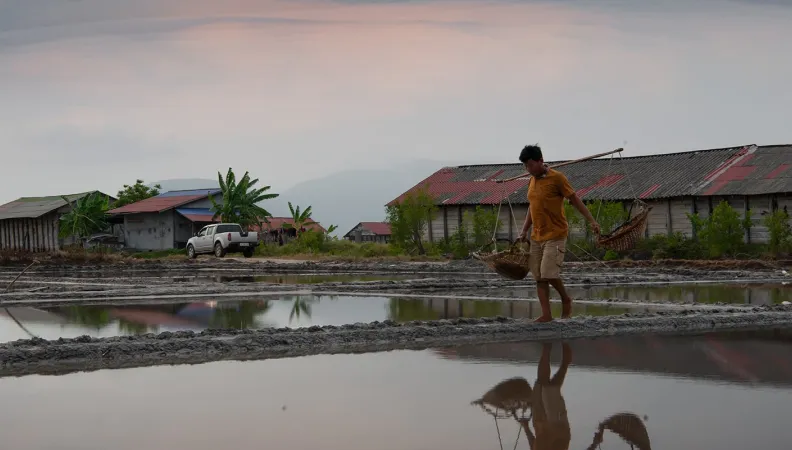Share the page
Bringing Distinct Local Products from across Cambodia to Global Markets
Published on

From the soil to the treetops, from the coasts to the mountains: Cambodia possesses an abundance of agricultural riches that are unique to certain regions and need to be produced with care. AFD is supporting a project that identifies and protects such products with the use of Geographical Indications – labels that confirm the authenticity of location-based products. This helps monitor and improve quality, boost sales and improve producers' incomes.
From Kampong Speu palm sugar, to Mondulkiri wild honey and Kampot salt and pepper, Cambodia has a rich food heritage distinguished by the local environment and expertise. Geographical Indications (GI) attest to the provenance, quality and reputation of some of the world's most important agricultural heritages. They also improve the lives of farmers and their families. GIs target rural workers who make up 95 percent of the poor and whose livelihoods depend on protecting their traditions and environment, but also on their ability to compete in the global agricultural marketplace.
Find out More about Geographical Indications: Supporting Rural Development and Valuing Countries' Hidden Treasures
The sweet taste of sustainability: Kampong Speu Sugar
The sandy soils and dry climate of Kampong Speu in southwest Cambodia provide perfect conditions for the Thnot tree’s palm sugar, which small-scale farmers have been cultivating since the Angkor era. The GI project ensures that the cultivation of Kampong Speu palm sugar (or “Skor Thnot Kampong Speu”) is cultivated sustainably, and contributes to name recognition on global markets.
"Between growing rice in the rainy season and making sugar in the dry season, we now have a stable income year-round, with greater market opportunities than ever before,” said Sem Ven, one of the farmers to benefit from the project.
Mondulkiri Honey, Cambodia’s liquid gold
Meas Por, 35 years old, climbs the gnarled trunk of a forest tree toward a huge bees' nest – a source of prized Cambodian honey. He looks across the vast expanse of the Mondulkiri forest in the largest yet least populated province in Cambodia, home to the Bunong ethnic group. They depend on the natural environment around them, but deforestation and climate change are threatening their livelihoods.
For them, the GI project is a real opportunity to escape poverty and preserve the forest. Since the GI was registered for local honey a year ago, the project has counted close to 500 honey collectors in the association, living in 11 community protected areas (CPA), and collecting 35 to 40 metric tons of honey yearly.
"We are finally able to support our families, put food on our table, send our children to school, while taking care of our forest, our land," says Meas Por.
Head south for salt and pepper
Kampot province in the south of the country is home to large pepper plantations. Farmer Chan Deng, beholds the peppercorns he rolls between his fingers. "They’re perfect now," he says. "You should try it on our traditional grilled fish tonight.” Grown the old-fashioned way, on vines that thrive in Kampot's unique soil and its coastal climate, local farmers harvest black, white green and red varieties.
Mr. Deng too, has seen benefits from the GI Project. Beyond a substantial increase in revenues, he sees renewed solidarity among the farming community. "We have more confidence. We can share our knowledge and experience with each other. This is the most important thing we need to ensure that our way of life here is sustainable for future generations."
Find out more about Sustainable Agriculture
Nurturing women’s power: Kampot Sea Salt
Thyda Thaung is the first woman in her family of salt producers to lead this traditionally male-dominated business. "I am well aware of the obstacles women face in this sector,” she says. “So I'm working to create more opportunities for women to work at all levels of the value chain, including decision-making and management."
She leads a team of 27 producers and really hopes that the salt will soon be registered as a geographical indication. "We are working with Gérande, for example, to understand what we need to do register our product. We are also working with the communities, to make them aware of the processes, and of the benefits they will be able to enjoy!"
Supporting the entire value chain
At the center of the project is a comprehensive process that highlights the unique traits of local and regional products along the chain from production to consumption. To earn the GI label, pepper, salt, sugar and honey must be cultivated according to strict standards, which make for high-quality products and invariably lead to improved earnings.
At the same time, professional associations are mobilized to make these GIs known. They verify compliance with GI requirements, and promote the products using the latest marketing strategies. Producer cooperatives have been formed for Kampong Speu sugar to monitor traceability and packaging before it is sold on the markets. Cooperatives allow producers to pool their resources in matters of storage, packaging and quality control.
This project is part of a wider regional project in Cambodia, Laos and Myanmar. AFD has been supporting the development of GIs in Southeast Asia since 2007.
